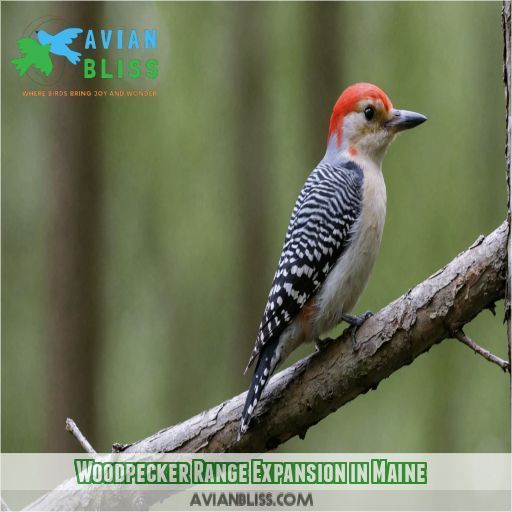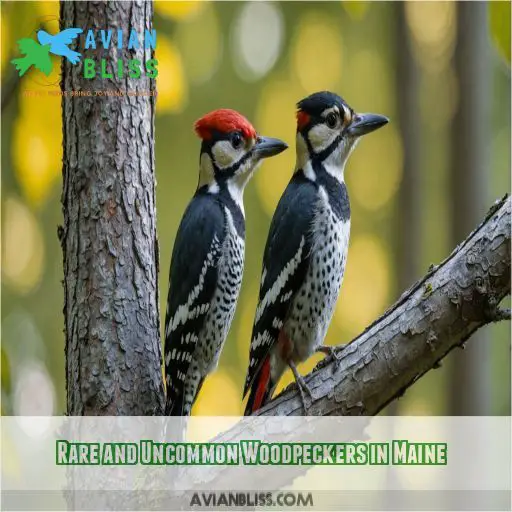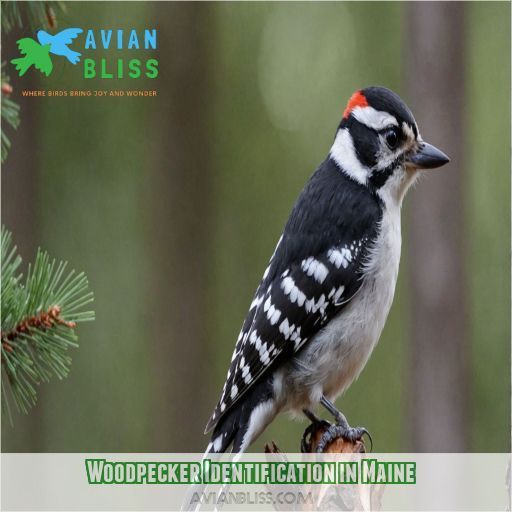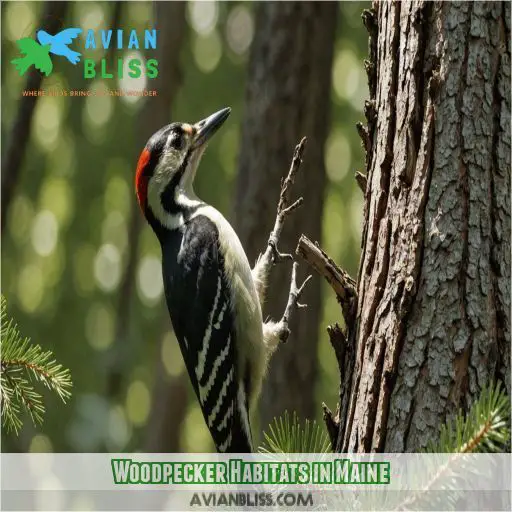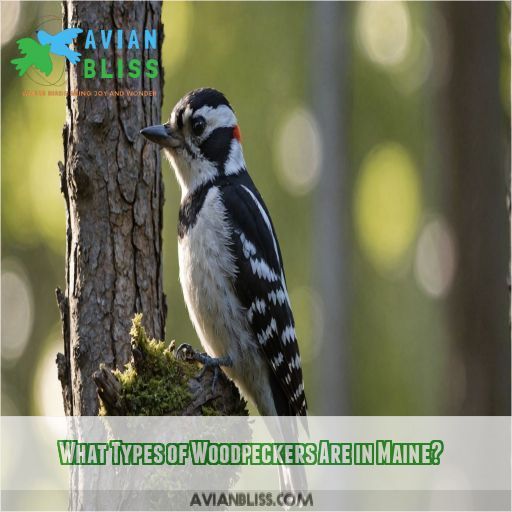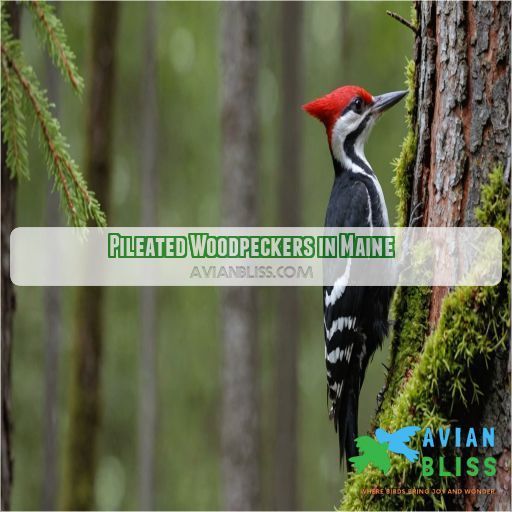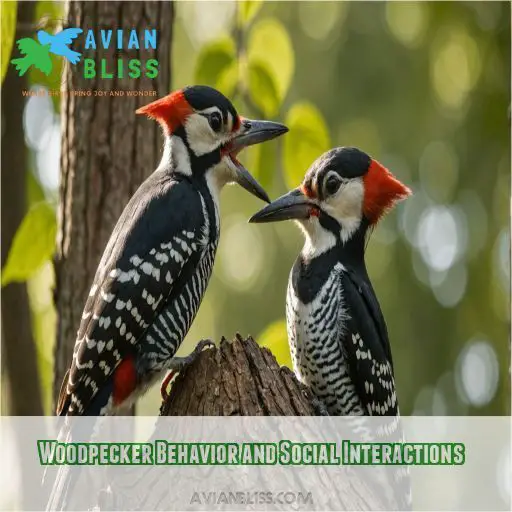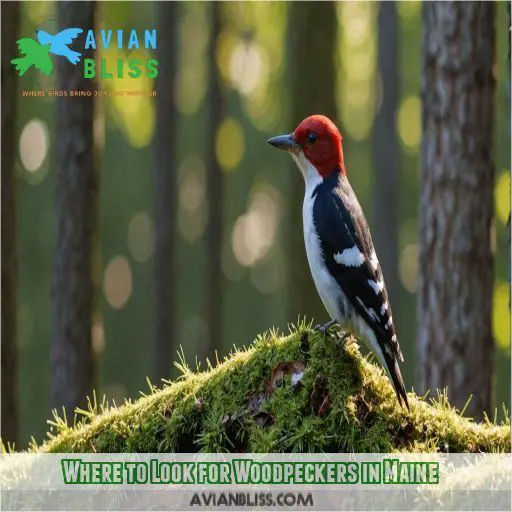This site is supported by our readers. We may earn a commission, at no cost to you, if you purchase through links.

With nine distinct species to discover, you’re in for a treat.
From the common Downy Woodpecker to the rare American Three-toed Woodpecker, each has unique characteristics and habits.
You might be surprised to learn that the Red-bellied Woodpecker is expanding its range in Maine, thanks to climate change and food availability.
As you explore the woodpeckers of Maine, you’ll learn how to identify them, where to spot them, and what makes each one special.
Table Of Contents
- Key Takeaways
- Common Woodpeckers in Maine
- Woodpecker Range Expansion in Maine
- Rare and Uncommon Woodpeckers in Maine
- Woodpecker Identification in Maine
- Woodpecker Habitats in Maine
- What Types of Woodpeckers Are in Maine?
- Differentiating Between Small Black and White Woodpeckers
- Pileated Woodpeckers in Maine
- Woodpecker Behavior and Social Interactions
- Where to Look for Woodpeckers in Maine
- Frequently Asked Questions (FAQs)
- What types of woodpeckers are in Maine?
- What are the small black and white woodpeckers in Maine?
- How do you tell woodpeckers apart?
- What is the most common woodpecker in New England?
- What do woodpeckers primarily eat in Maines forests and backyards?
- How do woodpeckers protect themselves from head injuries while drilling?
- What is the average lifespan of a woodpecker in Maine?
- Can woodpeckers be attracted to backyard bird feeders and suet?
- Are woodpeckers in Maine known to migrate to warmer climates?
- Conclusion
Key Takeaways
- You’ll discover nine distinct species of woodpeckers in Maine, each with its own unique characteristics and habits, from the common Downy Woodpecker to the rare American Three-toed Woodpecker.
- To tell these woodpeckers apart, you’ll need to become a bird detective, looking for distinctive markings, beak shapes, and plumage patterns—think red caps, black backs, or white undersides.
- Woodpeckers in Maine primarily eat insects, sap, and nuts, foraging for wood-boring insects, spiders, and other invertebrates, which makes them nature’s pest control.
- You can attract these amazing birds to your backyard with suet feeders, especially if you offer their favorite foods like peanuts, sunflower seeds, and mealworms—just be sure to use feeders with tail props to make them feel comfortable.
Common Woodpeckers in Maine
You’re about to meet the most common woodpeckers in Maine, and they’re a pretty fascinating bunch. From the tiny Downy Woodpecker to the striking Northern Flicker, these birds are a treat to spot in the state’s woodlands, backyards, and parks.
Downy Woodpecker Habitat and Behavior
As you explore Maine’s woodlands, keep an ear out for the Downy woodpecker‘s distinctive drumming patterns.
These small birds thrive in edge habitats, where deciduous and coniferous forests meet.
Downy woodpeckers are common visitors to backyard bird feeders, too!
They forage for insects, seeds, and berries, adapting to winter by caching food and relying on suet and sunflower seeds for survival.
Hairy Woodpecker Identification and Diet
You’re ready to meet the Hairy Woodpecker, a common sight in Maine’s woodlands. To identify them, look for a medium-sized bird with a black and white striped head, a longer bill than the Downy Woodpecker, and a distinctive red marking on the back of their head. Here are four key facts about the Hairy Woodpecker’s diet and behavior:
- Insect lovers: Hairy Woodpeckers primarily feed on insects, especially wood-boring insects.
- Drill masters: They excavate insects from trees using their powerful beaks.
- Fruit and sap: They also enjoy fruits, sap, and nuts, making them a common sight at bird feeders.
- Cavity dwellers: Hairy Woodpeckers often nest in cavities, making them a great species to spot in Maine’s woodlands.
Northern Flicker Foraging Habits and Range
As you explore Maine’s woodpecker scene, you’ll likely spot the Northern Flicker. These birds forage on the ground and in trees, snatching up insects, fruits, and seeds. Their diet is diverse, and they’ll even visit your backyard bird feeder. With two subspecies, Yellow-Shafted and Red-Shafted, you might notice the distinct coloration on their tails and wing feathers.
Red-bellied Woodpecker Population Trends
You’re interested in the Red-bellied Woodpecker population trends in Maine. Well, you’re in luck! Their numbers have been steadily increasing, with a notable surge in recent years . Climate change and food source availability are likely contributing factors . As they expand their range, they’re becoming a more common sight in the northeastern United States (Source).
Woodpecker Range Expansion in Maine
You’re about to explore one of the most fascinating aspects of Maine’s woodpecker world: range expansion. As you discover how woodpeckers like the red-bellied woodpecker are shifting their territories, you’ll learn what’s driving this change and how it’s affecting the state’s native woodpecker populations.
Red-bellied Woodpecker Migration Patterns
You’re tracking the red-bellied woodpecker‘s migration patterns in Maine! These birds typically migrate north for the summer breeding season, arriving in May and June. Climate change has shifted their habitat preferences, allowing them to venture further north. As a result, they’re now competing with native woodpeckers for resources. Their migratory routes are influenced by food availability and suitable breeding grounds.
Factors Contributing to Range Expansion
As you explore the Red-bellied Woodpecker‘s migration patterns, you might wonder what’s driving their range expansion in Maine. Climate change, habitat availability, and food sources all play a role. With warmer temperatures, these woodpeckers can thrive in areas previously too cold. Add abundant insects and sap-rich trees, and you’ve got a recipe for a happy, expanding woodpecker population.
Impact on Native Woodpecker Species
- Competition for Resources: As new species move in, native woodpeckers like the Pileated Woodpecker may face competition for food and habitat.
- Habitat Loss and Fragmentation: Increased competition may force native woodpeckers into smaller, less desirable habitats, leading to population declines.
- Disease Spread and Invasive Species: Non-native woodpeckers may introduce diseases or parasites, harming Maine’s native woodpecker populations, including the American Three-toed and Black-backed Woodpeckers.
Rare and Uncommon Woodpeckers in Maine
You’re about to meet the rare and uncommon woodpeckers of Maine – the American Three-toed Woodpecker, Black-backed Woodpecker, and Yellow-bellied Sapsucker – each with unique characteristics that set them apart from their more common counterparts. As you explore these fascinating birds, you’ll discover the specific habitats, diets, and behaviors that make them so interesting to observe and study.
American Three-toed Woodpecker Habitat and Diet
As you venture into Maine’s boreal forests, keep an eye out for the American Three-toed Woodpecker. This rare bird thrives in areas ravaged by forest fires, where it feasts on wood-boring insects. Its three-toed feet and specialized tongue make it a master of extracting prey from charred trees. Conservation threats loom, making sightings all the more precious.
Black-backed Woodpecker Identification and Foraging Habits
Get to know the elusive Black-backed Woodpecker! Found in Maine’s boreal forests, this rare bird is a sight to behold. To spot one, look for its distinctive black back and white undersides. Here are three reasons to care about this amazing bird:
- 1. Its habitat is threatened by climate change.
- 2. Conservation efforts are underway to protect its range.
- 3. Your sighting can contribute to its survival.
Yellow-bellied Sapsucker Range and Migration
You’re on the lookout for the Yellow-bellied Sapsucker. These rare woodpeckers migrate from their winter range in Central America and the southeastern United States to the northeastern United States, including Maine, for breeding season. Climate change is shifting their migration routes, but they still favor forests with sap-rich trees, where they drill sap wells to feast on the sweet stuff.
Woodpecker Identification in Maine
As you learn about Maine’s woodpeckers, you’ll want to develop your identification skills to spot the nine species that call the state home.
You can become a woodpecker expert by paying attention to key characteristics.
These characteristics include bill size and shape, plumage patterns and coloration, and head and facial markings.
Key Characteristics for Identification
Now that we’ve explored rare and uncommon woodpeckers in Maine, let’s get into the fun part – identifying them. When spotting a woodpecker, look for distinctive plumage patterns, head markings, wing patterns, and tail feather variations. These characteristics can help you distinguish between species, like the striking red head of the red-headed woodpecker.
Bill Size and Shape
When spotting woodpeckers in Maine, pay attention to bill size and shape – it’s a key ID feature. A larger bill, like the Hairy Woodpecker’s, is perfect for extracting insects from deep tree crevices. Smaller bills, like the Downy’s, are ideal for snatching bugs from shallow bark. This adaptation shows how evolution finds clever solutions.
Plumage Patterns and Coloration
When identifying woodpeckers in Maine, take a closer look at their plumage patterns and coloration. These unique features can help you pinpoint the species. Here are some key variations to note:
- Stripes and spots: Some woodpeckers have horizontal or vertical stripes, while others have spots or patches.
- Earth tones: Many woodpeckers have brown, gray, or tan plumage to blend in with their surroundings.
- Bright accents: Some species have vibrant red, yellow, or orange markings on their heads, backs, or wings.
- Sexual dimorphism: Males and females may have distinct coloration patterns, so keep an eye out for these differences.
Head and Facial Markings
When birdwatching in Maine’s forested areas and edge habitats, pay attention to the head and facial markings of woodpeckers.
Note the head shape and color variations, as these can help identify male versus female and specific species.
Unique patterns, such as the red cap on the Red-bellied Woodpecker or the yellow forehead on the American Three-toed Woodpecker, can be a giveaway.
Woodpecker Habitats in Maine
As you explore Maine’s woodpecker habitats, you’ll discover that each species has its own unique preferences in terms of forest types, urban areas, and edge habitats. From the deciduous forests favored by Downy Woodpeckers to the coniferous forests preferred by American Three-toed Woodpeckers, understanding these habitat preferences will help you track down the state’s nine woodpecker species.
Forest Types and Woodpecker Preferences
As you venture into Maine’s forests, keep in mind that woodpeckers have distinct preferences for tree types. Coniferous forests are home to the American Three-toed and Black-backed Woodpeckers, while deciduous forests attract Downy and Hairy Woodpeckers. Dead trees, especially after fires, provide a haven for fire-adapted species like the Black-backed Woodpecker.
Urban and Suburban Woodpecker Habitats
Maine’s forests are prime woodpecker habitat.
These adaptable birds have also made themselves at home in our backyards and urban areas.
Downy and Hairy Woodpeckers readily visit bird feeders stocked with black oil sunflower seeds.
You may spot them pecking away at the trees in your yard.
Though they face challenges from noise and habitat loss, woodpeckers have proven their ability to thrive alongside humans in Maine’s cities and suburbs.
Edge Habitats and Woodpecker Diversity
As you explore Maine’s woodpecker habitats, you’ll notice that edge habitats are a treasure trove of diversity. These areas between forests and open areas offer a unique mix of food sources and shelter. Here are three reasons why edge habitats are a woodpecker’s paradise:
- Variety of food sources: Edge habitats offer a mix of insects, sap, and seeds.
- Reduced competition: With more resources available, woodpeckers face less competition from other species.
- Human activity impact: Edge habitats are often created by human activities, such as logging or agriculture, which can inadvertently benefit woodpeckers.
What Types of Woodpeckers Are in Maine?
As you explore the great outdoors of Maine, you’ll discover a fascinating world of woodpeckers, with nine species calling the state home. From the tiny Downy Woodpecker to the majestic Pileated Woodpecker, each species has its unique characteristics, habits, and habitats, offering a thrilling experience for bird enthusiasts and nature lovers alike.
Overview of Common and Rare Species
Now that we’ve explored Maine’s woodpecker habitats, let’s get to know the locals. You’ll find nine species of woodpeckers in Maine, ranging from the tiny Downy to the majestic Pileated. Common species include Hairy, Northern Flicker, and Red-bellied woodpeckers, while rare visitors like the Black-backed and American Three-toed woodpeckers will keep you on your toes.
Seasonal Variations in Woodpecker Populations
As you explore Maine’s woodpecker populations, you’ll notice seasonal variations. In winter, many species visit backyard feeders, while breeding season brings territorial drumming. Migration patterns influence fall populations, with some species departing for warmer climates. Spring arrival timing varies, but typically occurs in late April or early May, when food availability increases (Source).
Regional Differences in Woodpecker Distribution
As you explore Maine’s woodpecker scene, keep in mind that regional differences play a significant role in their distribution. Climate change, habitat fragmentation, and species competition affect their ranges. In southern Maine, you’re more likely to spot Red-bellied Woodpeckers, while Northern Flickers dominate the north. Geographic barriers, like rivers and mountains, also influence their habitats and food availability.
Differentiating Between Small Black and White Woodpeckers
You’re out in the woods, binoculars in hand, and you spot a small black and white woodpecker – but is it a Downy or a Hairy? In this section, you’ll learn the key characteristics to tell these lookalike woodpeckers apart, as well as how to identify other similar species that might throw you for a loop.
Downy Vs. Hairy Woodpecker
Let’s tackle the age-old question: how do you tell Downy and Hairy Woodpeckers apart? It’s not as tricky as you think. Here are three key differences to look out for:
- Bill length: Hairy Woodpeckers have a longer bill than Downy Woodpeckers.
- Size comparison: Hairy Woodpeckers are larger overall.
- Sound differences: Listen for the Hairy Woodpecker’s more nasal, drawn-out call.
Other Similar-Looking Woodpecker Species
Now that you’ve mastered the Downy vs. Hairy woodpecker debate, let’s talk about other similar-looking species.
The Northern Flicker’s yellow or red shafts can be confusing, but look for their distinctive black bib.
The Yellow-bellied Sapsucker’s, well, yellow belly is a giveaway.
Meanwhile, the Red-headed Woodpecker’s bold red head is hard to mistake, but be careful not to confuse it with the Pileated’s crest.
Pileated Woodpeckers in Maine
As you explore Maine’s woodpecker scene, you’ll likely encounter the majestic Pileated Woodpecker, the state’s largest woodpecker species, measuring an impressive 17.5 inches in length. With its striking red crest and black body, this bird is a stunning sight to behold, and you’ll want to know more about its habits and habitats to increase your chances of spotting one.
Identification and Habitat Preferences
As you venture into Maine’s woods, keep an ear out for the Pileated Woodpecker‘s distinctive drumming call. To spot one, look for large, dead trees with nesting sites, often near water sources. Habitat conservation efforts have helped these woodpeckers adapt to urban areas, but they still prefer mature forests with abundant food sources, showcasing their remarkable adaptability.
Diet and Foraging Habits
When you’re learning about Pileated Woodpeckers in Maine, you’re probably curious about their diet and foraging habits. These birds primarily feed on insects, fruits, and sap. Here are some key facts:
- Insect prey: They love carpenter ants, beetle larvae, and wasps.
- Sap feeding: They lap up sap from trees, often creating sap wells.
- Fruit and nuts: Berries, cherries, and hazelnuts are favorite treats.
- Winter survival: They cache food for winter, storing insects and seeds in tree cavities.
Conservation Status and Threats
Now that we’ve explored the Pileated Woodpecker’s diet and foraging habits, let’s talk conservation status. Sadly, these magnificent birds face threats like habitat loss, climate change, disease, and pesticide use. Responsible forest management is key to preserving their habitats. By supporting sustainable forestry practices, you can help make sure the long-term survival of Pileated Woodpeckers in Maine.
Woodpecker Behavior and Social Interactions
As you explore the fascinating world of Maine’s woodpeckers, you’ll discover that their behavior and social interactions are just as intriguing as their distinctive pecks and colorful plumage.
From the complex Pileated Woodpeckers Mating rituals of the Pileated Woodpecker to the territorial drumming of the Downy Woodpecker, understanding these behaviors will help you better appreciate the intricate social lives of these charismatic birds
.
Mating and Breeding Habits
Love is a different kind of game for woodpeckers. As you learn about Maine’s woodpeckers, you’ll discover fascinating mating and breeding habits. Here are a few highlights:
- Courtship rituals involve drumming, calling, and aerial displays to impress potential mates.
- Brood size varies by species, but most woodpeckers lay 2-5 eggs per clutch.
- Nestling care is a shared responsibility, with both parents feeding and caring for their young.
Territorial Behavior and Communication
Woodpeckers are pretty serious about their territory! They use drumming to establish boundaries and warn off intruders. But that’s not all – they also use calls to communicate with potential mates and defend their nests. Let’s break it down:
| Behavior | Purpose |
|---|---|
| Drumming | Establish boundaries, warn off intruders |
| Calls | Communicate with potential mates, defend nests |
| Nest defense | Protect young from predators |
| Boundary disputes | Resolve territorial conflicts |
| Mating displays | Attract a mate, showcase skills |
Think of it like a woodpecker’s way of saying, "Hey, this is my turf!
Flocking Behavior and Social Structure
You’re about to enter the fascinating world of woodpecker social dynamics. Imagine a flock of woodpeckers, each playing their role in the social hierarchy. As you observe their behavior, you’ll notice:
- Dominant birds leading the flock to food sources
- Mating rituals involving drumming and displays of plumage
- Territorial disputes settled with aggressive displays
- Cooperative foraging during winter months
- Young woodpeckers learning social skills from their elders
Where to Look for Woodpeckers in Maine
As you set out to spot Maine’s fascinating woodpeckers, you’ll want to know where to look, and luckily, the state offers a range of exciting locations to explore. From scenic state parks and nature reserves to your own backyard, with the right tips and tricks, you can increase your chances of catching a glimpse of these incredible birds.
State Parks and Nature Reserves
When searching for woodpeckers in Maine, consider visiting state parks and nature reserves. These areas provide a haven for woodpeckers, with diverse habitats and minimized human impact. Check out the following parks for a chance to spot these amazing birds.
| Park | Location | Woodpecker Species |
|---|---|---|
| Acadia National Park | Mount Desert Island | Downy, Hairy, Pileated |
| Baxter State Park | Millinocket | Black-backed, American Three-toed |
| Wolfe’s Neck Woods State Park | Freeport | Red-bellied, Northern Flicker |
| Allagash Wilderness Waterway | Northern Maine | Yellow-bellied Sapsucker |
| Aroostook National Wildlife Refuge | Limestone | Red-headed Woodpecker |
Remember to respect park rules and minimize your impact on these amazing habitats.
Backyard Birding and Feeding Tips
Now that you’ve explored Maine’s state parks and nature reserves, let’s bring the woodpeckers to your backyard! Attract these amazing birds with the right food and feeders. Here are three tips to get you started:
- Suet feeders: Woodpeckers love high-energy suet, especially during winter.
- Sunflower seeds: Offer sunflower seeds, a favorite snack of many woodpecker species.
- Nest box placement: Install nest boxes in dead trees or poles to attract woodpeckers.
Guided Tours and Woodpecker Viewing Spots
Join a guided Maine woodpecker tour with expert guides who’ll take you to the best viewing spots. Opt for private excursions to maximize your chances of spotting these amazing birds. Don’t forget your camera! Photography tips from your guide will help you capture stunning shots. Get ready for an unforgettable adventure in Maine’s beautiful woodpecker country!
Frequently Asked Questions (FAQs)
What types of woodpeckers are in Maine?
Knock on wood!" You’re in luck because Maine’s home to a diverse array of woodpeckers, including Downy, Hairy, Northern Flicker, Red-bellied, and Pileated woodpeckers, each with unique characteristics and habitat preferences.
What are the small black and white woodpeckers in Maine?
You’re likely spotting Downy Woodpeckers, Maine’s smallest and most common woodpeckers, measuring 1 inches. They’ve black wings with white spots and are found throughout the state, often visiting backyard bird feeders.
How do you tell woodpeckers apart?
Good luck, Sherlock! To tell woodpeckers apart, you’ll need to become a bird detective. Look for distinctive markings, beak shapes, and plumage patterns. Look for red caps, black backs, or white undersides – each species has its own unique style.
What is the most common woodpecker in New England?
You’re probably wondering which woodpecker you’re most likely to spot in New England! It’s the Downy Woodpecker, the smallest and most common woodpecker in the region, measuring just 1 inches with its distinctive black and white spots.
What do woodpeckers primarily eat in Maines forests and backyards?
Don’t worry, woodpeckers won’t raid your snack stash! In Maine’s forests and backyards, they primarily eat insects, sap, and nuts (Source). They forage for wood-boring insects, spiders, and other invertebrates, making them nature’s pest control .
How do woodpeckers protect themselves from head injuries while drilling?
You might wonder how woodpeckers avoid headaches from drilling. Well, their skulls have strong, spongy bones that absorb shock, and their brains are surrounded by cerebrospinal fluid, which acts as a cushion to protect them from impact.
What is the average lifespan of a woodpecker in Maine?
You’re curious about woodpeckers’ lifespan. On average, a woodpecker in Maine lives around 2-5 years in the wild, although some species, like the Downy Woodpecker, can live up to 10 years.
Can woodpeckers be attracted to backyard bird feeders and suet?
You can attract woodpeckers to your backyard with suet feeders, especially if you offer their favorite foods like peanuts, sunflower seeds, and mealworms . Use feeders with tail props to make them feel comfortable .
Are woodpeckers in Maine known to migrate to warmer climates?
You might be wondering if woodpeckers migrate to warmer climates. Well, some Maine woodpeckers, like the Northern Flicker, do migrate, while others, such as the Downy and Hairy Woodpeckers, are year-round residents, sticking around for the winter.
Conclusion
Wondering woodpeckers welcome you to their world!
As you wander through Maine’s woodlands, keep an eye out for the nine distinct species that call this state home.
From the common Downy Woodpecker to the rare American Three-toed Woodpecker, each has unique characteristics and habits.
Now that you know the woodpeckers of Maine, grab your binoculars and head outside to spot these fascinating birds in their natural habitats.
Happy birding!


